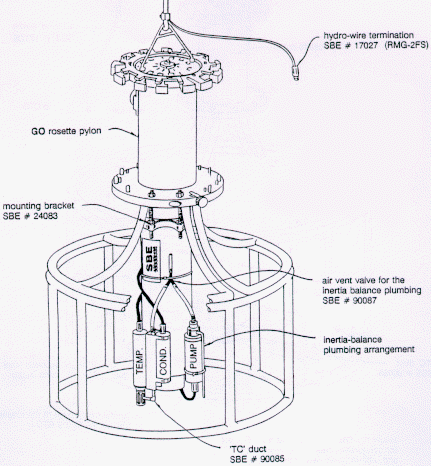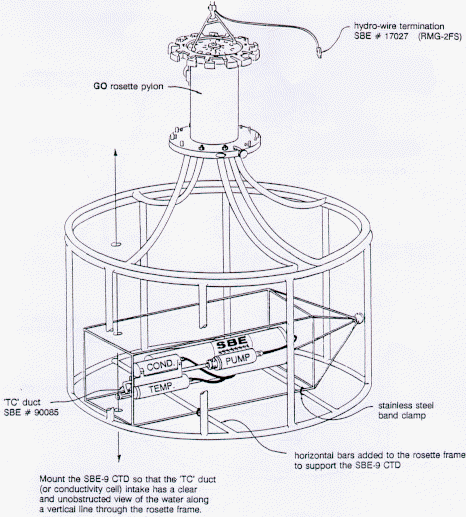APPLICATION NOTE NO. 35
Use of SBE 911plus CTD with
General Oceanics 1015 Rosette®
Revised February 1992
![]()
The Sea-Bird SBE 911plus CTD system is electrically and mechanically compatible with standard, unmodified Rosette water samplers made by General Oceanics (G-O). The SBE 911plus can be ordered with the optional modem and Rosette interfaces. These items allow the SBE 911plus to control the operation of the Rosette directly and without interrupting the data from the CTD. Use of the SBE 911plus in this way eliminates the need for the G-O deck box.
Vertical mounting of the CTD to the Rosette pylon is shown below. The CTD underwater unit (SBE 9) is removed from its stainless-steel guard cage and a special clamp (Sea-Bird #24083, General Oceanics # C1015-SB-2) is fixed just under the CTD's top end cap flange. Four heavy threaded rods pass through this clamp and secure the CTD assembly to the Rosette's lower bottle plate. An extension stand must be used to provide sufficient height to protect the CTD sensors when the Rosette is on deck. Consult General Oceanics for the extension stand appropriate for your Rosette. Note that the CTD will be in the 'wake' of the Rosette during the upcast; the Rosette will modify the temperature of the water as it passes through, and the CTD will respond accordingly. Optimum data quality cannot be obtained under these conditions, and only the downcast data should be used. If the 'TC Duct' is employed, the plumbing connections are the same as without the Rosette.

Horizontal mounting of the CTD may be feasible where the Rosette frame is of sufficient diameter, shown below. A somewhat smaller diameter will suffice if the CTD is removed from its cage and mounted with suitable clamps. Notice that the pump position is altered and the 'return tubing' deleted; in the horizontal configuration there is no vertical component to the water in the system. This makes the system inherently insensitive to ship's motion induced vertical accelerations. By positioning the TC Duct intake close to the Rosette frame's periphery and out of the wake of the pylon/bottle assembly, it may be possible to obtain good upcast in addition to downcast data.

The SBE 9plus is connected to the G-O Rosette using a three-pin jumper cable (P/N 17196, reverse polarity cable). When using this cable, the switch in the Rosette pylon should be set for 'reverse polarity'. It is possible to use a Rosette set for 'normal polarity' by connecting a different cable (P/N 17533, normal polarity cable) between the G-O pylon and the CTD Rosette connector.
Note that with the SBE 9plus there is no Y-cable between the sea cable termination, the CTD, and the Rosette, as is used with older SBE 9 systems and EG&G CTDs. The sea cable is connected directly to the CTD at connector JT1. A jumper cable is then used between CTD connector JT4 and the connector on the Rosette pylon. (See SBE drawing no. 50076 or 50077 and figure 3)
The firing of the bottles on the Rosette can be accomplished by three different methods. During the display of real time data using Seasave, function keys [CTRL] F3 can be used to enable and fire bottles (if the computer serial port is connected to the modem port on the SBE 11plus). The buttons on the front panel of the deck unit can be used in a similar manner, whether or not the primary logging computer has its serial port connected to the modem port. A third option is to connect a second computer to the modem communications port on the SBE 11plus and use the program TMODEM to control the Rosette operation.
If the bottle has been enabled, sending a fire signal will cause the immediate closing of the enabled bottle on the Rosette. If the bottle has not been enabled, sending a fire command will initiate a 15-second arming sequence followed by the firing of the bottle.
When the SBE 9plus underwater unit detects a bottle confirmation from the G-O Rosette it:
1) sends a confirm message to the computer connected to the modem port
2) sets a bit high in the modulo word for 1.5 sec. The confirm bit is a permanent mark in the CTD data stream for later ID and processing of the Rosette bottle data and is used by Seasave to keep track of the number of bottles fired.
Note: If the Rosette pylon has been enabled, turning off the deck unit power will cause the pylon to fire. This situation can cause bottles to trip in unexpected locations. Tripping a bottle on deck may be hazardous.

![]()
Sea-Bird Home Phone: (+1) 425-643-9866 Fax: (+1) 425-643-9954 E-mail: seabird@seabird.com